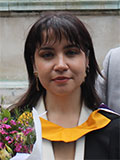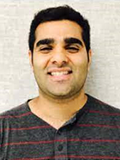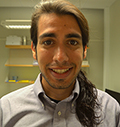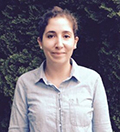Student Profiles
Current Students

Maddy Barrett - 2023
As a student in the NIH-KI collaborative doctoral program, Maddy studies the development of therapeutics for the treatment of multi-drug resistant glioblastoma multiforme (GBM) under the mentorship of Dr. Elias Arnér (Karolinska Institutet) and Dr. Matthew Hall (NCATS/NIH). Her research focuses on discovering selective inhibitors of glutathione peroxidase (GPx) enzymes, which are selenoprotein antioxidant enzymes. GPxs are attractive targets for the treatment of GBM and other cancer types.
Maddy is from Oregon and earned a B.S. in Biology from Oregon State University. Before pursuing her PhD, she worked at Oregon Health and Science University (OHSU) in Portland, OR. There she studied the effects of myocardial infarction (heart attack) on sympathetic neuron morphology in Dr. Sue Aicher’s lab before transitioning to a role in the Knight Cancer Institute in clinical research. As a clinical coordinator in the Serial Measurements of Molecular and Architectural Responses to Therapy (SMMART) precision oncology initiative, she worked with oncology patients participating in clinical trials, sparking an interest in translational research for her doctoral studies.
Maddy’s project pairs well with the high-throughput screening capabilities at NCATS in the Early Translational Branch and selenoprotein enzyme expertise in the Medical Biochemistry and Biophysics (MBB) at KI. She conducts high-throughput screens to identify selective GPx1 and GPx4 inhibitors as potential treatment for GBM. Maddy also plans to utilize the selective probes to further understand the roles and interactions of GPx enzymes in disease pathways such as GBM.

Rose Temizer - 2023
Rose graduated with a BSc from New York University where she majored in Neural Science and minored in Chemistry and Nutrition. During her time at NYU, she worked in Dr. Chiye Aoki’s laboratory where she researched ketamine’s mechanism of action in the activity-based animal model of anorexia. Following graduation, she worked in Dr. Alison Goate’s laboratory at Icahn School of Medicine at Mount Sinai as a research associate. There she generated iPSC derived microglia to study the genetic mechanisms underlying Alzheimer’s Disease.
Combining her interests in psychiatric disease and genetics, Rose is now pursuing a PhD under the mentorship of Dr. Francis McMahon at the National Institute of Mental Health and Dr. Carl Sellgren at Karolinska Institutet. Her doctoral project is focused on better understanding the genetic mechanisms underlying bipolar disorder. She is using patient derived iPSC to generate brain organoids to study transcriptomic and proteomic pathways underlying disease.

Carolyn Lomahan - 2023
Carolyn is from outside of Chicago and she graduated from the University of Pittsburgh with a B.S. in Neuroscience. During her undergraduate studies, she worked in Dr. Anthony Kline’s lab at the Safar Center for Resuscitation Research at the UPMC Children’s Hospital of Pittsburgh. For three years, she worked on preclinical research that focused on restoring the quality of cognitive and motor function after a TBI by implementing pharmacotherapy and/or environmental enrichment to attenuate TBI-induced deficits.
Following graduation, Carolyn gained experience in clinical research with the NINDS Stroke Program at Suburban Hospital, affiliated with Johns Hopkins Medicine. The NIH/NINDS Stroke Program is unique in the use of MRI to triage acute stroke patients and for research follow-up MRI, rather than CT. Carolyn was responsible for quality aspects of clinical data and neuroimaging in addition to developing quantitative MRI processing techniques for projects with Dr. Marie Luby, a NIH/NINDS Senior Imaging Scientist. As part of that effort, Carolyn developed a method to estimate cerebral edema and began to focus on studying the pathogenesis of secondary injury following acute stroke using MRI.
With continued interest in neuroimaging and secondary injury following ischemia, Carolyn matriculated into the NIH-KI Program and aims to focus on imaging markers of hyperemia, cerebral autoregulation, and angiogenesis to better understand cerebrovascular injury and stroke patients’ response to mechanical thrombectomy. Her projects will be a collaboration between Dr. Lawrence Latour, a NIH/NINDS Senior Scientist, and Dr. Fabian Arnberg-Sandor, Head of Neurointervention at Karolinska University Hospital, as well as Dr. Luby (NIH/NINDS), Dr. Staffan Holmin (KI), and Dr. Johan Lundberg (KI).

Michelle Olofsson – 2023
Michelle Olofsson grew up in Lexington, MA, before moving to the U.K. to pursue her BSc in Biomedical Sciences at Imperial College London. While studying at Imperial, Michelle developed a background in data analysis and epidemiological research, with her undergraduate thesis focused on extracting patterns in palliative radiotherapy care across NHS England. During this time, Michelle was also exposed to work at Imperial’s Centre for Psychedelic Research. This sparked a passion for cognitive neuroscience and psychiatric research, prompting Michelle to pursue her PhD in this area.
As a doctoral student in the NIH-KI program, Michelle is studying under the mentorship of Dr. Tonya White (NIMH), Dr. Predrag Petrovic (KI), Dr. Alexander Lebedev (KI), and Dr. Otto Simonsson (KI). In her research, Michelle is applying her epidemiological background to the study of psychedelic use and its effects on mental health outcomes. Her work focuses on investigating these associations in specific and vulnerable populations, such as those with histories of early life traumatic experiences. Michelle is spending her first 2 years in Stockholm, before returning to the NIH for the duration of her studies.
Outside of her work, Michelle likes to spend her time running, xc-skiing, thrifting, and going to concerts with friends. Feel free to reach out if you have any questions for Michelle at: michelle.olofsson@ki.se.

Maia Moog – 2021
Maia grew up in San Francisco, California but left for the East Coast at age 18 to attend Skidmore College where she majored in Neuroscience. Following her graduation in 2014, Maia spent several years gaining research experience and exploring alternative career paths; she cycled across America, taught English to high school students in Austria, worked as a public health regional research fellow in Cambodia, and spent nine months in a retail position selling crafting materials. Eventually, however, she found her way back to neuroscience when she joined the Baraban Epilepsy Research Lab at the University of California, San Francisco. The Baraban Laboratory uses zebrafish models for several forms of human genetic epilepsy, in an effort to eventually create an avenue for personalized treatment. Maia was involved in screening the zebrafish and conducted forebrain EEG field recordings, and later on, post-op genotyping. Her experience at the Baraban Lab solidified her interest in research and gave her the confidence to apply to the NIH-KI Graduate Partnership Program.
Maia’s doctoral project, a collaborative effort between Dr. Kenton Swartz at the National Institutes of Health and Dr. Patrik Ernfors at the Karolinska Institutet, focuses on a special type of Schwann cell at the dermal-epidermal border in the skin that plays a role in the initiation and propagation of mechanical pain. Over the course of her four years, she will draw upon the expertise of the two labs to characterize the electrophysiological and molecular properties of these Schwann cells to determine the mechanosensitive and voltage sensitive ion channels at play.
Outside of the laboratory, Maia enjoys metalsmithing and riding her bike aimlessly around any city she finds herself in. If you have any questions about her path to the NIH or her project, feel free to send her an email at: maia.moog@nih.gov.

Jacob Short - 2021
Jacob Short received his BSc from the University of Maine where he studied Bioengineering and Ethics. He worked with Dr. Paul Millard on portable devices for genetic tagging and identification. This provided as understanding that nature is the finest bioengineer, and synthetic materials can only hope to fulfill as many simultaneous functions as the simplest animal tissue. He continued studying Bioengineering at Wilkes University in Pennsylvania with dual tracks in Biomedical Imaging, with Dr. Abas Sabouni, and Synthetic Biology, with Dr. Del Lucent. He received his MSc for research using magnetite particles generated by magneto-tactic bacteria in microwave mammography. He also worked as an organizer for elementary and middle school groups during summer outreach programs. Explaining biology and engineering to kids provides invaluable practice at science communication.
Jacob moved to Fairfax, Virginia, in 2016 with his wife Lisa who was earning her MFA from George Mason University. He got a job as Lab Manager for Dr. Quan Yuan, a neuroplasticity researcher working with Drosophila. He gained experience in neuroscience, advanced genetic engineering, and the financial mechanisms of the NIH. Jacob contributed to multiple research project in the lab over five years before applying to the NIH/Karolinska GPP.
Jacob started working in Dr. Susan Wray’s lab in 2021. Dr. Wray is an expert in the hypothalamic-pituitary-gonadal axis which controls reproduction. Jacob is building stem cell-derived neurons for transplantation to reverse the effects of polycystic ovarian syndrome, which is rooted in diseased signaling from the hypothalamus. His collaborators at Karolinska are Dr. Ola Hermanson, an expert in neural progenitor stem cells, and Dr. Robert Harris, an expert in neuroglia who has successfully transplanted functional neurons in mice. Jacob is spending the first two years at the NIH building his mouse model and plans to spend the last two years in Stockholm along with his wife, dog, and two ferrets.

Kasra Zarei – 2021
Through the NIH-KI PhD program, Kasra is pursuing a PhD in global health under the mentorship of Dr. Kelvin (Tsz) Choi at NIMHD, and Dr. Anna-Clara Hollander and Dr. Predrag Petrovic at the Karolinska Institute.
Kasra’s research focus is on multicultural health, traumatic experiences and other social determinants of health and disparities among immigrants, refugees and other underserved populations in the U.S. and Sweden, including children with Resignation Syndrome, using epidemiological and multi-disciplinary approaches and collaborations with non-governmental organizations in Sweden. He also seeks to learn and practice the Swedish concept of “Lagom”.
Kasra completed his undergraduate education and Master of Health Administration at the University of Iowa, where he is also a medical student. He has worked with local and state health departments and plans to become a pediatrician and work in global public health domestically and internationally, with a focus on serving underserved populations.
Alumni

Dorian Cheff - 2023
Dorian was born and raised in White Lake, MI, and attended college at the University of Michigan where she graduated with a B.S. in Neuroscience in 2015. As an undergraduate, she worked under Dr. Anuska Andjelkovic-Zochowska in the Pathology Department, focusing on characterizing claudin-protein interactions in the tight junctions of the blood-brain barrier in cases of chronic stroke. In 2013, she was awarded a Biomedical and Life Sciences Summer Fellowship through the Undergraduate Research Opportunity Program to continue her research in Dr. Andjelkovic-Zochowska’s lab, concluding her internship with an oral presentation to her peers and faculty of her findings at UROP’s summer symposium.
After graduation, Dorian joined Dr. Matthew Hall’s group at the National Center for Advancing Translational Science (NCATS) Chemical Genomics Center as a post-baccalaureate Intramural Research Training Award (IRTA) Fellow. There, she worked to develop and miniaturize biochemical and cell-based assays for high-throughput evaluation of novel small molecule inhibitors for epigenetic and metabolic cancer targets. Dorian also worked on small molecule matrix combination studies in order to identify synergistic combinations for more efficacious therapies.
As a NIH/KI student, Dorian will divide her time between the Chemical Genomics Center with Dr. Matthew Hall and the Department of Medical Biochemistry and Biophysics (MBB) with Dr. Elias Arnér at the Karolinska Institute, characterizing and identifying inhibitors of glutathione peroxidase (GPx) 1 and 4 as a potential therapeutic target for multidrug-resistant glioblastoma multiforme.

Elliot Glotfelty - 2023
Elliot Glotfelty received B.S. degrees in Chemistry and Biology at Towson University in 2011. During his senior year at Towson, Elliot had the opportunity to participate in a research project investigating the neuroanatomy of the chronic stress pathway. Following graduation, Elliot’s newly fostered passion for research led to employment in an educational fellowship with the US Army Medical Research Institute of Chemical Defense, where he worked on a variety of projects and publications under the mentorship of Dr. Patrick McNutt. Elliot worked under Dr. McNutt until mid 2017, prior to matriculation into the NIH-KI GPP program.
Along with a passion for science and research, Elliot has lived and volunteered abroad in both Thailand and Honduras, working with international non-governmental organizations on website development, research projects, and educational infrastructure. Science education and cross cultural interaction has also been a passion for Elliot, marrying the two as he has worked for several years developing science curriculum and teaching for an online English as a Second Language school based out of China. The opportunity to work and study in both the United States at the NIH and Sweden at the Karolinska Instituet was the perfect match for Elliot’s pursuit of his PhD in a neuroscience program.
Starting in Fall 2017, Elliot will begin his thesis work at the National Institute of Aging in Baltimore under the mentorship of Dr. Nigel Greig. Dr. Greig is a senior investigator at the Gerontology Research Center, where he has been developing and introducing drug interventions for Alzheimer’s disease. In combination with Dr. Greig’s pharmacological expertise, Elliot will work under the co-mentorship of Dr. Lars Olson at the Karolinska Instituet, who has specialized in the development and characterization of a variety of transgenic mouse models for neurodegenerative diseases. Elliot’s focus of research will involve investigation and interruption of neurodegeneration, specifically in models of Alzheimer’s disease. Elliot comes into the NIH-GPP program with a wide variety of skillsets, with specific expertise in microscopy and immunostaining techniques.
Elliot is a certified yoga teacher and enjoys practicing yoga and meditation in his free time. In addition, Elliot enjoys photography, traveling, and playing guitar and singing with his band in local venues.

Troy Dildine - 2022
Troy is pursuing a PhD in neuroscience between the National Center for Complementary & Integrative Health at the National Institutes of Health (NIH) and the Clinical Neuroscience Department at Karolinska Institutet with Drs. Lauren Atlas & Andreas Olsson. Troy is using neuroimaging and psychophysiological measures, along with computational modeling and machine learning techniques, to study patient-doctor interactions and health disparities in pain. Troy received a BA in Neuroscience with honors from Dartmouth College, spent a year as a research assistant at the University of Colorado Boulder, and spent two year as a postbac IRTA at the NIH. Outside of the laboratory, Troy enjoys running (to the top of mountains), gardening (with his hands full of dirt), and fikas (with lots of friends and colleagues)!

Heather L. Rusch - 2020
Heather L. Rusch is a Clinical Investigator at the National Institutes of Health (NIH). She earned her MS in Neuroscience at Columbia University in the City of New York and completed her clinical training at the New York State Psychiatric Institute, PTSD Research and Treatment Program under the direction of Dr. Yuval Neria. Upon graduation, Heather joined Dr. Jessica Gill’s lab at the NIH as a Senior Clinical Research Associate. Here she utilized a combination of genomic, proteomic, neural, and physiological markers to determine the factors associated with resilience to, and risk for, insomnia, depression, and PTSD following mild traumatic brain injury in human participants.
In 2017, Heather matriculated into the NIH-Karolinska PhD Graduate Partnership Program in Clinical Neuroscience under the mentorship of Dr. Mats Lekander and Dr. Julie Lasselin. Her thesis focused on the links between perceived stress, sleep, and inflammation and actions to translate these findings to foster psychological, physiological, and molecular resilience in humans. To achieve this, Heather utilized a variety of techniques including behavioral studies (e.g., mindfulness meditation), ultra-sensitive digital biomarker detection technology, and advanced RNA sequencing applications. This integrative approach capitalizes on burgeoning advances in neuroscience and may inform new insights into pathogenic markers and targeted therapeutics for individuals suffering with stress-related disorders.
In 2020, Heather successfully defended her PhD. The health policy implications of her research have been featured in several popular health magazines and on Psychology Today. Heather is currently serving as Co-Investigator on an international study investigating the effects of different behavioral treatments on increased resilience in healthcare workers that care for patients with COVID-19.

Neel Nabar - 2019
My name is Neel Nabar and I’m a joint MD/PhD Training Fellow through the NIH-KI partnership program and Sidney Kimmel Medical College at Thomas Jefferson University. I am also the co-founder of a bio-pharmaceutical company, Cognition Life Science, and a delegate to the American Medical Association. Prior to joining the NIH, I worked on immune based therapies at the Byrd Alzheimer’s Institute (Tampa, FL) where I developed a candidate vaccine for Alzheimer’s disease. I was also an integral member of the team that first showed the potential therapeutic effect of THC on Alzheimer’s, and have been featured in several documentaries and political talk shows to discuss the health policy implications of this work. Currently, I work with Dr. John Kehrl on innate immune mechanisms in macrophages harboring Parkinson’s disease mutations, and have a strong interest in digital health.

Lora D. Weidner - 2017
Lora Deuitch Weidner received a BS in Neuroscience from the University of Pittsburgh. From there, she worked as a research specialist for two years in a PET imaging lab at the same university. During this time, she helped to conduct PET imaging studies in patients with drug dependence, schizophrenia, as well as healthy participants. Lora’s mentor, Dr. Rajesh Narendran, told her about the NIH-KI graduate partnership program after he attended a presentation given by a then current NIH-KI GPP student. Lora joined the NIH-KI GPP program in 2013 under mentorship from Dr. Robert B. Innis (NIMH), Dr. Matthew D. Hall (NCI/NCATS), and Dr. Jan Mulder (KI). Her thesis was “ABC transporters and inflammation in drug-resistant epilepsy,” which involved measuring the expression of ABC transporters and inflammatory proteins in surgical brain tissue samples. In addition, Lora also validated the use of two ABC transporter inhibitors for their use in PET imaging. Lora successfully defended her thesis in 2017.
After graduating, Lora continued her PET imaging research under Dr. Innis as a post-doctorate. During this time, she conducted a PET imaging study investigating the expression of PDE4 in patients with McCune-Albright syndrome compared to healthy controls. In 2019 Lora left NIH to pursue a career at the Center for Devices and Radiological Health (CDRH) at the Food and Drug Administration. Lora is currently a scientific reviewer for nuclear medicine and radiation therapy devices and finds the job both challenging and rewarding.

Saket Milind Nigam - 2017
Saket Milind Nigam, a native Stockholmer, grew up in both Sweden and the US throughout his childhood. After completing a B.Sc. in Human Physiology at the University of Oregon and an M.Sc. in Biomedicine at the Karolinska Institute, Saket entered the NIH-KI GPP in 2012 to keep a foot in both countries while benefitting from the unique learning opportunity of working between two labs. He was supervised jointly by Dr. Mark Mattson (LNS, NIA) and Dr. Lennart Brodin (Department of Neuroscience). Cumulatively, his PhD thesis aimed to uncover mechanisms for amyloid precursor protein processing and trafficking with relevance to Alzheimer’s Disease (AD). Notably, he published work on the role that exercise and BDNF have on the pathogenesis of AD. Saket completed his Ph.D. in June 2017 and hopes to translate his research into solutions for AD patients.

Stal Shrestha - 2014
Stal Shrestha started his research career at Gary Strichartz’s lab at Harvard. There, he studied behavioral and cellular mechanisms of postoperative pain. His findings resulted in a first-author publication in the Journal of Pain (2009). While presenting his research at the SfN meeting, he learned about the joint NIH-Karolinska PhD graduate partnership program in Clinical Neuroscience. In 2010, he matriculated to this program under the mentorship of Robert Innis, and Per Svenningsson. He conducted translational research using PET imaging and molecular techniques. In 2014, he successfully defended his PhD with eight publications—four were first-authored. Notably, all of these were published in major scientific journals prior to his dissertation. One of these—a high-risk, high-profile project involving several collaborators—was published in The American Journal of Psychiatry. The study found that fluoxetine (an SSRI), when administered to juvenile monkeys, persistently upregulated serotonin transporter into young adulthood. This finding underscored the need for practitioners to exercise caution in prescribing SSRIs to young adults, and suggested that further studies in humans are necessary to explore the mechanisms underlying the persistence of these effects. Due to its potential clinical impact, the article was accompanied with an editorial by world-renowned child psychiatrists and behavioral psychologists.
Currently, Stal is a postdoctoral fellow at the NIH working on neuroinflammation and DREADDs (Designer Receptor Exclusively Activated by Designer Drugs) under the mentorship of Victor Pike, Barry Richmond, and Robert Innis. His main project focuses on developing PET radiotracers for the cyclooxygenase (COX) system. The COX system comprises of two primary isoforms, COX-1 and COX-2, which are key enzymes associated with neuroinflammation. Towards this end, Stal screened, evaluated, and developed a primate model of neuroinflammation to validate two PET COX radiotracers for neuroinflammation—11C-PS13 for COX-1 and 11C-MC1 for COX-2. Stal found that while COX-1 is constitutively expressed in major organs, including brain COX-2 is inducible only after inflammation. As such, COX-2 is a biomarker for active inflammation in brain, and 11C-MC1 is the first successful COX-2 PET radiotracer. These findings are particularly important because they suggest that these radiotracers can be used to measure COX-1 and COX-2 in neuroinflammatory disorders as well as to measure delivery to the brain of non-steroidal anti-inflammatory drugs (NSAIDs) and other potential therapeutic treatments—both would be significant advances in the field of clinical neuroscience. His other project uses PET for visualizing DREADD expression using 11C-Clozapine. DREADDs uses synthetic drugs, and can help modulate circuit activity with pharmacological interventions, and as such has the power to transform the field of clinical neuroscience and how we practice medicine.
In summary, Stal’s scientific pursuits have resulted in three primary discoveries: 1) SSRIs (e.g. Prozac) have persistent effects when administered during adolescence; 2) 11C-PS13 is the first PET radiotracer to successfully image COX-1, which is the major target of NSAIDs.; and 3) 11C-MC1 is the first PET radiotracer to successfully image COX-2, and detects active neuroinflammation. He is the recipient of the American College of Neuropsychopharmacology and Alavi–Mandell Nuclear Medicine Excellence Awards in 2017, International Young Professionals award in Translational Neuroscience in 2016, Henry M. Jackson postdoctoral fellowship for the Advancement of Military Medicine in 2015, and NIH Fellows Award Research Excellence in 2014.

